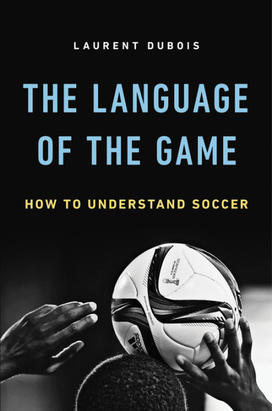Laurent Dubois ’92 Reveals the ‘Language’ of Soccer
The book: Soccer is the most widely played sport in the world — with professional clubs on six continents, it is enjoyed by men and women of all ages. Its worldwide appeal and simple premise make it, according to Laurent Dubois ’92, a common storytelling language to the billions of people who watch and play it.
The Language of the Game: How to Understand Soccer (Basic Books) is an overview of the main archetypes that populate each game of soccer and how they contribute to the games’ stories. Part history and part love letter, Dubois devotes chapters to common characters such as “The Defender,” “The Manager,” and “The Fan,” buttressed with anecdotes, player biographies, and interviews concerning both the men and women’s games. Although critical at times of the politics surrounding the sport, The Language of the Game is primarily an exultation of the game’s drama, spectacle, and beauty.
The author: Laurent Dubois ’92 is a professor of romance studies and history at Duke University, where he teaches the popular course “Soccer Politics.” He is the author of five books, including The Banjo, Haiti, and Soccer Empire, and lives in Durham, N.C.
Opening lines: What is soccer?
It is a game you play on a rectangle of ground bracketed by two goals, one at either end. That shape is everywhere. Fly into almost any city in the world and look down, and you will see it — probably with people running back and forth, whether it is morning, midday, or night.

Soccer is possibility. In Chile there is an expression, rayando la cancha, which means “marking the field.” It is what you do to transform a place into a soccer pitch, an action so common in Chile that the expression can be used to describe any kind of beginning.
All you need is a ball. If you don’t have one, you can make one. And even if you don’t have one, you can play. That is what a group of boys do in the film Timbuktu, by Mauritanian director Abderrahmane Sissako, when the Islamist group that has taken over their town bans the sport and takes away their ball. In one of the most beautiful sequences I have seen in any film, the boys play the game anyway. They dribble and tackle. Take a penalty kick. Score a goal. Celebrate.
The ball is unnecessary, in the end, because soccer, more than anything, is an idea.
Soccer is life. In her account of traveling the world looking for pickup soccer games to join, former U.S. collegiate soccer star and filmmaker Gwendolyn Oxenham writes of visiting a park in Rio de Janeiro. There, waiters gather after their restaurants close. They start playing at midnight and often keep going until dawn, delighting in the movement and creativity that defines Brazilian futebol. “I wash the dishes, I sweep the floors, I put the chairs up on the table,” one player tells her, “and then I come here to play, to live.” Oxenham understands. “For as long as I can remember,” she writes, “futebol has been how I come all the way alive.”
Soccer comes from a specific place and time: the schools and universities of nineteenth-century Great Britain. The Laws of the Game, which still govern how soccer is played, were first set down in 1863. Because of the country’s dominant global presence—not only through the British Empire but also through the British merchants and companies based outside the colonies—the game was soon on the move. It spread quickly. By the end of the nineteenth century, it was being played in Europe, Latin America, Southeast Asia, and throughout much of Africa, even in areas outside the British Empire’s sphere of influence. The game has shown a remarkable capacity to flourish nearly everywhere it has taken root. Played in Senegal, it seems as completely Senegalese as any other form of local culture. Soccer is absolutely German. It is absolutely Argentinean. It is absolutely Haitian. And, of course, it is perhaps above all absolutely Brazilian. In fact, the English often have to remind the rest of us that they were the ones who invented it. As perpetually beleaguered English fans know, at least when it comes to global competition, having invented the game hasn’t given them much of an advantage.
There are good reasons for soccer’s universal appeal. It is a simple game, easy to learn and grasp. A few instructions, a finger pointed at the goal, and off you go. It is democratic in this sense, and also in the way that it accommodates all kinds of body shapes and sizes. In fact many great soccer players are of slight or short physique. “I love the way that small men can destroy big men,” writes the novelist Nick Hornby, an ardent fan of the English club Arsenal. “Strength and intelligence have to combine” to make a great player.
Reviews: “A collection of wisdom gleaned from a lifetime of reading about his beloved sport ... If your soccer fandom needs a tuneup before the World Cup, this book will more than suffice. But the real pleasure comes in Dubois’ attempt to arrive at a kind of philosophical ideal for each position he describes.” — New York Times Book Review
“Thoughtful and eye-opening ... Fans and neophytes alike will appreciate this eclectic offering and its passionate view of soccer’s global influence.” — Library Journal












1 Response
Robert Buntrock *67
7 Years AgoA Wonderful Game
Having both coached and refereed youth soccer, I was impressed with the simplicity of the rules, only 18 (thinnest rulebook in existence, I'm sure). Other than "measurements" and positioning -- out of bounds, goals, etc. -- all the rules regard the safety of the players. In addition, the origins in England are obvious because even though the game is played in countries most of which use the metric system, all measurements of the field and goals are English.
Wonderful game, a must buy for our family.